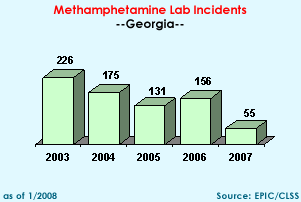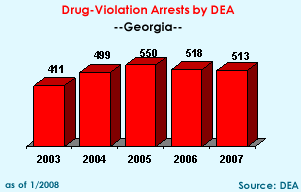|
DEA
Offices & Telephone Nos.
Atlanta—404-893-7000
Augusta—706-724-9021
Columbus—706-649-7850
Macon—478-757-8754
Rome—706-232-5104
Savannah—912-447-1035 |
State Facts
Population: 9,072,576
State Prison Population: 51,104
Probation Population: 419,350
Violent Crime Rate
National Ranking: 19 |
2007
Federal Drug Seizures
Cocaine: 1,218.0 kgs.
Heroin: 3.4 kgs.
Methamphetamine: 16.4 kgs./1
du
Marijuana: 2,028.0 kgs./3 du
Hashish: 100.5 kgs.
MDMA: 0.0 kgs./47,041 du
Meth
Lab Incidents: 55
(DEA, state, and local) |
Drug
Situation: The state of Georgia is both a final destination point for drug shipments and a smuggling corridor for drugs transported along the East Coast. Extensive interstate highway, rail, and bus transportation networks, as well as international, regional, and private air and marine ports of entry serve the state. Moreover, Georgia is strategically located on the I-95 corridor between New York City and Miami, the key wholesale-level drug distribution centers on the East Coast and major drug importation hubs. In addition, Interstate Highway 20 runs directly into Georgia from drug entry points along the southwest border and Gulf Coast. The city of Atlanta has become an important strategic point for drug-trafficking organizations (DTOs) as it is the largest city in the South and is a nexus for all East/West and North/South travel. The Mexico-U.S. Southwest Border area continues to be the primary source and staging area for cocaine, methamphetamine, marijuana, and heroin introduced into the Atlanta Field Division.
There are 9.3 million legal residents in the state of Georgia, of which Hispanics account for over 5 percent of the population. The Hispanic population growth has been aided by an influx of undocumented immigrants, mostly from Mexico. Intelligence currently indicates that as the Mexican immigrant community has grown so too has the presence of Mexican traffickers. With that growth, Mexican poly-drug organizations have been identified as the largest foreign threat in the state, predominantly trafficking in cocaine, methamphetamine, marijuana, and heroin. Moreover, Mexican traffickers now supply kilogram quantities of cocaine HCl directly to local crack cocaine dealers.
Additionally, enforcement activities have aided identifying smuggling routes, concealment methods, and money-laundering operations employed by other foreign DTOs, such as Southeast Asian, West African, South American, and the Caribbean.
Poly-Drug: Mexican
traffickers and Mexican DTOs continue to play an increasingly dominant
role in the importation and distribution of illegal drugs within Atlanta
Division Office. Mexican poly-drug organizations are the largest foreign
threat in the state, predominantly trafficking in cocaine, methamphetamine,
marijuana, and heroin. Mexican traffickers now supply kilogram quantities
of cocaine HCl directly to local crack cocaine dealers.
 Cocaine:
Cocaine and crack cocaine continue to be among the most widely available drugs throughout Georgia. Bulk quantities of powder cocaine are transported into the state most often from the Southwest border. Often the powder cocaine is converted into crack by the local wholesaler or retailer. Primary source areas for cocaine are located in Texas. Although traffickers use several transportation modes, the predominant methods of smuggling are the use of private or rental vehicles and tractor-trailers with increasingly sophisticated hidden compartments, travel routes, and counter-surveillance techniques. There has also been an increase in cover loads being used to secrete cocaine shipments. These loads are many times a legitimate load of fruits or vegetables with kilogram quantities of cocaine commingled throughout. Cocaine:
Cocaine and crack cocaine continue to be among the most widely available drugs throughout Georgia. Bulk quantities of powder cocaine are transported into the state most often from the Southwest border. Often the powder cocaine is converted into crack by the local wholesaler or retailer. Primary source areas for cocaine are located in Texas. Although traffickers use several transportation modes, the predominant methods of smuggling are the use of private or rental vehicles and tractor-trailers with increasingly sophisticated hidden compartments, travel routes, and counter-surveillance techniques. There has also been an increase in cover loads being used to secrete cocaine shipments. These loads are many times a legitimate load of fruits or vegetables with kilogram quantities of cocaine commingled throughout.
 Heroin:
Heroin availability remains stable throughout Atlanta metropolitan area. Seizures of street-level amounts of heroin attest to the pervasiveness and the availability of the drug. Typically, South American, followed by Southwest Asian and Mexican, has been the predominant type of heroin in the Atlanta area. However, the most recent domestic monitor program report has shown the reemergence of Southwest Asian heroin in the Atlanta market. The average purity for the Southwest Asian exhibits was 24.2 percent, and South American exhibits averaged 27 percent. Heroin:
Heroin availability remains stable throughout Atlanta metropolitan area. Seizures of street-level amounts of heroin attest to the pervasiveness and the availability of the drug. Typically, South American, followed by Southwest Asian and Mexican, has been the predominant type of heroin in the Atlanta area. However, the most recent domestic monitor program report has shown the reemergence of Southwest Asian heroin in the Atlanta market. The average purity for the Southwest Asian exhibits was 24.2 percent, and South American exhibits averaged 27 percent.
 Methamphetamine:
Methamphetamine continued a five-year trend as Atlanta’s fastest growing drug problem. This trend is particularly true in the Atlanta, Dalton, and Gainesville metropolitan areas. Since 2002, most of the significant methamphetamine seizures in the state were the result of stash/distribution site raids or state/local interdiction stops. Methamphetamine clandestine laboratories located within the state have declined since legislation was enacted in 2005 to restrict the sale of over-the-counter products containing pseudoephedrine: It is one of the essential chemicals used in producing methamphetamine. However, there has also been a corresponding increase in the availability of methamphetamine-Ice in the Atlanta metropolitan area. Methamphetamine:
Methamphetamine continued a five-year trend as Atlanta’s fastest growing drug problem. This trend is particularly true in the Atlanta, Dalton, and Gainesville metropolitan areas. Since 2002, most of the significant methamphetamine seizures in the state were the result of stash/distribution site raids or state/local interdiction stops. Methamphetamine clandestine laboratories located within the state have declined since legislation was enacted in 2005 to restrict the sale of over-the-counter products containing pseudoephedrine: It is one of the essential chemicals used in producing methamphetamine. However, there has also been a corresponding increase in the availability of methamphetamine-Ice in the Atlanta metropolitan area.
  Club
Drugs: Atlanta is a transit city for Ecstasy (MDMA) to other U.S. cities. MDMA, GHB, and Ketamine continue to be popular and remain readily available around populations of young people (gyms, college campuses and associated “hang outs”) throughout the state. LSD is usually encountered at school settings and is imported to Georgia mostly from the West Coast via U.S. Postal Service packages or commercial express mail. The wholesale cost of Ecstasy, depending on location and amount purchased, varies between $3 and $15 per pill and the retail price varies between $8 (Atlanta) and $25 (Savannah). Ecstasy is readily available in Atlanta’s nightclubs, “Rave” parties, and concerts that target the younger population. Club
Drugs: Atlanta is a transit city for Ecstasy (MDMA) to other U.S. cities. MDMA, GHB, and Ketamine continue to be popular and remain readily available around populations of young people (gyms, college campuses and associated “hang outs”) throughout the state. LSD is usually encountered at school settings and is imported to Georgia mostly from the West Coast via U.S. Postal Service packages or commercial express mail. The wholesale cost of Ecstasy, depending on location and amount purchased, varies between $3 and $15 per pill and the retail price varies between $8 (Atlanta) and $25 (Savannah). Ecstasy is readily available in Atlanta’s nightclubs, “Rave” parties, and concerts that target the younger population.
 Marijuana: Marijuana, the most commonly abused drug in Georgia, is readily available throughout the state. Mexico and the Southwest Border are the usual sources of marijuana imported and distributed in Georgia. The primary wholesale suppliers of marijuana are Mexican nationals. Outdoor cannabis cultivation sites are increasing due to the normally ideal growing condition in the region. Because of DEA's Domestic Cannabis Eradication and Suppression Program and the recent drought, some dealers have resorted to hydroponic cultivation of marijuana. Marijuana: Marijuana, the most commonly abused drug in Georgia, is readily available throughout the state. Mexico and the Southwest Border are the usual sources of marijuana imported and distributed in Georgia. The primary wholesale suppliers of marijuana are Mexican nationals. Outdoor cannabis cultivation sites are increasing due to the normally ideal growing condition in the region. Because of DEA's Domestic Cannabis Eradication and Suppression Program and the recent drought, some dealers have resorted to hydroponic cultivation of marijuana.
  Other
Drugs: Diverted pharmaceuticals are widely available. Other
Drugs: Diverted pharmaceuticals are widely available.
Pharmaceutical Diversion: The diversion of hydrocodone and oxycodone products (such as Vicodin®) and OxyContin®) continues to be a problem in Georgia. Primary methods of diversion being reported are illegal sale and distribution by health care professionals and workers, “doctor shopping” (going to a number of doctors to obtain prescriptions for a controlled pharmaceutical), and the Internet. Xanax® and Lorcet® were also identified as being among the most commonly abused and diverted pharmaceuticals in Georgia.
DEA Mobile Enforcement Teams: This
cooperative program with state and local law enforcement counterparts
was conceived in 1995 in response to the overwhelming problem of drug-related
violent crime in towns and cities across the nation. Since the inception
of the MET Program, 473 deployments have been completed nationwide, resulting
in 19,643 arrests. There have been 13 MET deployments in the State of
Georgia since the inception of the program: Columbus, Bowden, Atlanta,
Marietta, Macon, Glynn County, Dalton, Griffin, College Park, Savannah,
Gainesville, Milledgeville, and Barrow County.
 DEA
Regional Enforcement Teams:
This program was designed to augment existing DEA division resources
by targeting drug organizations operating in the United States where
there is a lack of sufficient local drug law enforcement. This Program
was conceived in 1999 in response to the threat posed by drug trafficking
organizations that have established networks of cells to conduct drug
trafficking operations in smaller, non-traditional trafficking locations
in the United States. As of January 31, 2005, there have been 27 deployments
nationwide, and 1 deployment in the U.S. Virgin Islands, resulting in
671 arrests. There has been one RET deployment in Dalton, Georgia, since
the inception of the program. DEA
Regional Enforcement Teams:
This program was designed to augment existing DEA division resources
by targeting drug organizations operating in the United States where
there is a lack of sufficient local drug law enforcement. This Program
was conceived in 1999 in response to the threat posed by drug trafficking
organizations that have established networks of cells to conduct drug
trafficking operations in smaller, non-traditional trafficking locations
in the United States. As of January 31, 2005, there have been 27 deployments
nationwide, and 1 deployment in the U.S. Virgin Islands, resulting in
671 arrests. There has been one RET deployment in Dalton, Georgia, since
the inception of the program.
Other
Enforcement Operations: The Office of National Drug Control Policy (ONDCP) established the Atlanta High Intensity Drug Trafficking Area (HIDTA) in 1995. The Atlanta HIDTA’s mission is two fold: It targets drugs and violence within DeKalb County, Cobb County, Gwinnett County, and Fulton County, as well as the city of Atlanta. There are 13 agencies participating in the Atlanta HIDTA, five of which are federal agencies.
More information
about the Atlanta Division Office.
Sources
Factsheet
last updated:
3/2008
Click
here for last year's factsheet >>
|

